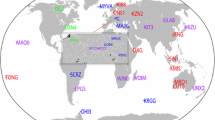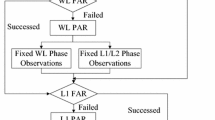Abstract
Estimating inter-system biases (ISBs) is important in multi-constellation Global Navigation Satellite System (GNSS) processing. The present study aims to evaluate and screen out an optimal estimation strategy of ISB for multi-GNSS kinematic precise point positioning (PPP). The candidate strategies considered for ISB estimation are white noise process (ISB-WN), random walk process (ISB-RW), constant (ISB-CT) and eliminated by between-satellite single-differenced observations (ISB-SD). We first present the mathematical model of ISB derived from the observation combination among different GNSSs, and we demonstrate the equivalence between ISB-WN and ISB-SD in the Kalman filter. In order to evaluate the performance of these four ISB solution strategies, we implement kinematic PPP with 1-month static data from 112 International GNSS service stations and two-hour dynamic vehicular data collected in an urban case. For comparison, precise orbit and clock products from the Center for Orbit Determination in Europe (CODE), GeoForschungsZentrum in Germany (GFZ) and Wuhan University (WHU) are employed in our experiments. The results of static tests show that the positioning accuracy is comparable among the four strategies, but ISB-CT performs slightly better in convergence time. In the kinematic test, there are more cycle slips than static test, and the ISB-CT improves the positioning accuracy by 15.7%, 38.9% and 63.2% in east, north and up components, and reduces the convergence time by 60.1% comparing with the other strategies. Moreover, both the static and kinematic tests prove the consistence among CODE, GFZ and WHU precise products and the equivalence between ISB-WN and ISB-SD strategies. Finally, more, i.e., the same amount of cycle slips as for the dynamic data, are artificially added to the static data to conduct the pseudo-kinematic test. The result shows that ISB-CT improves the positioning accuracy and convergence time by 19.2% and 24.4%, respectively.









Similar content being viewed by others
Data availability
The MGEX station observations, multi-GNSS precise orbit and clock products can be achieved at https://cddis.nasa.gov/archive/gnss/. The other datasets employed in this study are available from the corresponding author.
References
De Bakker PF, Tiberius CCJM (2017) Real-time multi-GNSS single-frequency precise point positioning. GPS Solut 21(4):1791–1803. https://doi.org/10.1007/s10291-017-0653-2
Cai C, Gao Y (2013) Modeling and assessment of combined GPS/GLONASS precise point positioning. GPS Solut 17(2):223–236. https://doi.org/10.1007/s10291-012-0273-9
Dixon TH (1991) An introduction to the global positioning system and some geological applications. Rev Geophys 29(2):249–276. https://doi.org/10.1029/91rg00152
Gao W, Meng X, Gao C, Pan S, Wang D (2018) Combined GPS and BDS for single-frequency continuous RTK positioning through real-time estimation of differential inter-system biases. GPS Solut 22(1):1–13. https://doi.org/10.1007/s10291-017-0687-5
Guo J, Xu X, Zhao Q, Liu J (2016) Precise orbit determination for quad-constellation satellites at Wuhan University: strategy, result validation, and comparison. J Geod 90(2):143–159. https://doi.org/10.1007/s00190-015-0862-9
Hong J, Tu R, Gao Y, Zhang R, Fan L, Zhang P, Liu J (2019) Characteristics of inter-system biases in Multi-GNSS with precise point positioning. Adv Space Res 63(12):3777–3794. https://doi.org/10.1016/j.asr.2019.02.037
Jiang N, Xu Y, Xu T, Xu G, Sun Z, Schuh H (2017) GPS/BDS short-term ISB modelling and prediction. GPS Solut 21(1):163–175. https://doi.org/10.1007/s10291-015-0513-x
Jiang N, Xu T, Xu Y, Xu G, Schuh H (2019) Assessment of different stochastic models for inter-system bias between GPS and BDS. Remote Sens. https://doi.org/10.3390/rs11080989
Kouba J (2015) A guide to using international GNSS service (IGS) products. In. https://kb.igs.org/hc/en-us/articles/201271873-A-Guide-to-Using-the-IGS-Products. Accessed 11 January 2022
Leick A, Rapoport L, Tatarnikov D (2015) GPS satellite surveying. John Wiley & Sons
Li P, Zhang X (2014) Integrating GPS and GLONASS to accelerate convergence and initialization times of precise point positioning. GPS Solut 18(3):461–471. https://doi.org/10.1007/s10291-013-0345-5
Li X, Zhang X, Ren X, Fritsche M, Wickert J, Schuh H (2015) Precise positioning with current multi-constellation global navigation satellite systems: GPS, GLONASS Galileo and BeiDou. Sci Rep 5(1):1–14. https://doi.org/10.1038/srep08328
Liu T, Yuan Y, Zhang B, Wang N, Tan B, Chen Y (2017) Multi-GNSS precise point positioning (MGPPP) using raw observations. J Geod 91(3):253–268. https://doi.org/10.1007/s00190-016-0960-3
Liu X, Jiang W, Chen H, Zhao W, Huo L, Huang L, Chen Q (2019) An analysis of inter-system biases in BDS/GPS precise point positioning. GPS Solut 23(4):1–14. https://doi.org/10.1007/s10291-019-0906-3
Meguro JI, Murata T, Takiguchi JI, Amano Y, Hashizurne T (2009) GPS multipath mitigation for urban area using omnidirectional infrared camera. IEEE Trans Intell Transp Syst 10(1):22–30. https://doi.org/10.1109/tits.2008.2011688
Montenbruck O et al (2017) The multi-GNSS experiment (MGEX) of the international GNSS service (IGS) - achievements, prospects and challenges. Adv Space Res 59(7):1671–1697. https://doi.org/10.1016/j.asr.2017.01.011
Mysen E (2017) On the equivalence of Kalman filtering and least-squares estimation. J Geod 91(1):41–52. https://doi.org/10.1007/s00190-016-0936-3
Paziewski J, Wielgosz P (2015) Accounting for Galileo-GPS inter-system biases in precise satellite positioning. J Geod 89(1):81–93. https://doi.org/10.1007/s00190-014-0763-3
Petit G, Luzum B (2010) IERS conventions (2010). In: IERS Technical Note No. 36. Verlag des Bundesamts für Kartographie und Geodäsie, Frankfurt am Main. http://www.iers.org/TN36/
Prange L, Orliac E, Dach R, Arnold D, Beutler G, Schaer S, Jaggi A (2017) CODE’s five-system orbit and clock solution-the challenges of multi-GNSS data analysis. J Geod 91(4):345–360. https://doi.org/10.1007/s00190-016-0968-8
Sanz J, Juan JM, Hernández-Pajares M (2013) GNSS data processing. In: Fletcher K (ed) Fundamentals and algorithms, vol I. ESA Communications, Noordwijk
Schaffrin B, Grafarend E (1986) Generating classes of equivalent linear models by nuisance parameter. Manuscr Geod 11:262–271
Sokhandan N, Curran JT, Broumandan A, Lachapelle G (2016) An advanced GNSS code multipath detection and estimation algorithm. GPS Solut 20(4):627–640. https://doi.org/10.1007/s10291-015-0475-z
Tian Y, Liu Z, Ge M, Neitzel F (2018) Determining inter-system bias of GNSS signals with narrowly spaced frequencies for GNSS positioning. J Geod 92(8):873–887. https://doi.org/10.1007/s00190-017-1100-4
Xu G, Xu Y (2016) GPS observation equations and equivalence properties. GPS: theory, algorithms and applications, 3rd edn. Springer, Berlin Heidelberg, Berlin, Heidelberg, pp 133–185. https://doi.org/10.1007/978-3-662-50367-6_6
Zhang B, Hou P, Zha J, Liu T (2021) Integer-estimable FDMA model as an enabler of GLONASS PPP-RTK. J Geod 91:1–21. https://doi.org/10.1007/s00190-021-01546-0
Zhou F, Dong D, Li P, Li X, Schuh H (2019) Influence of stochastic modeling for inter-system biases on multi-GNSS undifferenced and uncombined precise point positioning. GPS Solut 23(3):1–13. https://doi.org/10.1007/s10291-019-0852-0
Acknowledgements
The study is funded by Laoshan Laboratory (LSKJ202205104, LSKJ202205104_01), National Key Research and Development Program of China (2020YFB0505800, 2020YFB0505804), National Natural Science Foundation of China (42004012), Natural Science Foundation of Shandong Province, China (ZR2020QD048) and by the project RTI2018-094295-B-I00 funded by the MCIN/AEI 1013039/501100011033 which is co-funded by the FEDER program.
Author information
Authors and Affiliations
Corresponding author
Additional information
Publisher's Note
Springer Nature remains neutral with regard to jurisdictional claims in published maps and institutional affiliations.
Rights and permissions
Springer Nature or its licensor (e.g. a society or other partner) holds exclusive rights to this article under a publishing agreement with the author(s) or other rightsholder(s); author self-archiving of the accepted manuscript version of this article is solely governed by the terms of such publishing agreement and applicable law.
About this article
Cite this article
Li, M., Rovira-Garcia, A., Nie, W. et al. Inter-system biases solution strategies in multi-GNSS kinematic precise point positioning. GPS Solut 27, 100 (2023). https://doi.org/10.1007/s10291-023-01443-3
Received:
Accepted:
Published:
DOI: https://doi.org/10.1007/s10291-023-01443-3




